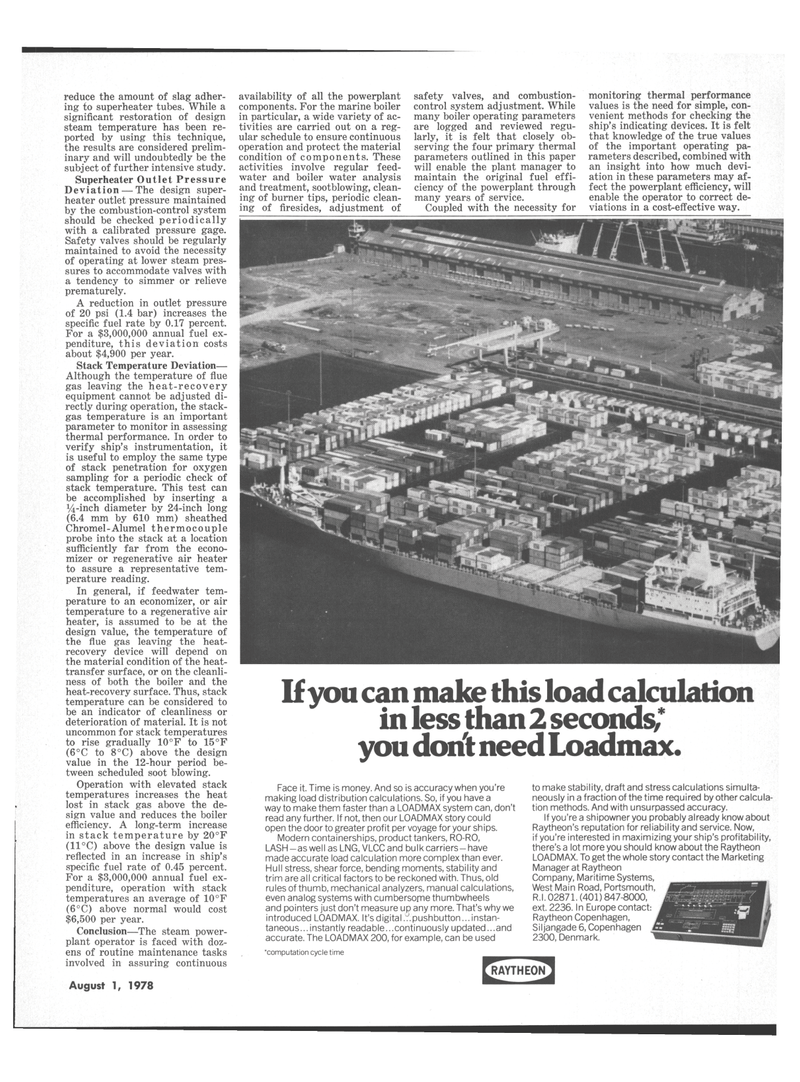
Page 33: of Maritime Reporter Magazine (August 1978)
Read this page in Pdf, Flash or Html5 edition of August 1978 Maritime Reporter Magazine
reduce the amount of slag adher- ing to superheater tubes. While a significant restoration of design steam temperature has been re- ported by using this technique, the results are considered prelim- inary and will undoubtedly be the subject of further intensive study.
Superheater Outlet Pressure
Deviation — The design super- heater outlet pressure maintained by the combustion-control system should be checked periodically with a calibrated pressure gage.
Safety valves should be regularly maintained to avoid the necessity of operating at lower steam pres- sures to accommodate valves with a tendency to simmer or relieve prematurely.
A reduction in outlet pressure of 20 psi (1.4 bar) increases the specific fuel rate by 0.17 percent.
For a $3,000,000 annual fuel ex- penditure, this deviation costs about $4,900 per year.
Stack Temperature Deviation—
Although the temperature of flue gas leaving the heat-recovery equipment cannot be adjusted di- rectly during operation, the stack- gas temperature is an important parameter to monitor in assessing thermal performance. In order to verify ship's instrumentation, it is useful to employ the same type of stack penetration for oxygen sampling for a periodic check of stack temperature. This test can be accomplished by inserting a ^-inch diameter by 24-inch long (6.4 mm by 610 mm) sheathed
Chromel-Alumel thermocouple probe into the stack at a location sufficiently far from the econo- mizer or regenerative air heater to assure a representative tem- perature reading.
In general, if feedwater tem- perature to an economizer, or air temperature to a regenerative air heater, is assumed to be at the design value, the temperature of the flue gas leaving the heat- recovery device will depend on the material condition of the heat- transfer surface, or on the cleanli- ness of both the boiler and the heat-recovery surface. Thus, stack temperature can be considered to be an indicator of cleanliness or deterioration of material. It is not uncommon for stack temperatures to rise gradually 10°F to 15°F (6°C to 8°C) above the design value in the 12-hour period be- tween scheduled soot blowing.
Operation with elevated stack temperatures increases the heat lost in stack gas above the de- sign value and reduces the boiler efficiency. A long-term increase in stack temperature by 20°F (11°C) above the design value is reflected in an increase in ship's specific fuel rate of 0.45 percent.
For a $3,000,000 annual fuel ex- penditure, operation with stack temperatures an average of 10°F (6°C) above normal would cost $6,500 per year.
Conclusion—The steam power- plant operator is faced with doz- ens of routine maintenance tasks involved in assuring continuous
August 1, 1978 35 availability of all the powerplant components. For the marine boiler in particular, a wide variety of ac- tivities are carried out on a reg- ular schedule to ensure continuous operation and protect the material condition of components. These activities involve regular feed- water and boiler water analysis and treatment, sootblowing, clean- ing of burner tips, periodic clean- ing of firesides, adjustment of safety valves, and combustion- control system adjustment. While many boiler operating parameters are logged and reviewed regu- larly, it is felt that closely ob- serving the four primary thermal parameters outlined in this paper will enable the plant manager to maintain the original fuel effi- ciency of the powerplant through many years of service.
Coupled with the necessity for monitoring thermal performance values is the need for simple, con- venient methods for checking the ship's indicating devices. It is felt that knowledge of the true values of the important operating pa- rameters described, combined with an insight into how much devi- ation in these parameters may af- fect the powerplant efficiency, will enable the operator to correct de- viations in a cost-effective way.
If you can make this load calculation in less than 2 seconds/ you donlt need Loadmax.
Face it. Time is money. And so is accuracy when you're making load distribution calculations. So, if you have a way to make them faster than a LOADMAX system can, don't read any further. If not, then our LOADMAX story could open the door to greater profit per voyage for your ships.
Modern containerships, product tankers, RO-RO,
LASH-as well as LNG, VLCC and bulk carriers-have made accurate load calculation more complex than ever.
Hull stress, shear force, bending moments, stability and trim are all critical factors to be reckoned with. Thus, old rules of thumb, mechanical analyzers, manual calculations, even analog systems with cumbersome thumbwheels and pointers just don't measure up any more. That's why we introduced LOADMAX. It'sdigital.^.pushbutton...instan- taneous ... instantly readable...continuously updated...and accurate. The LOADMAX 200, for example, can be used •computation cycle time to make stability, draft and stress calculations simulta- neously in a fraction of the time required by other calcula tion methods. And with unsurpassed accuracy.
If you're a shipowner you probably already know about
Raytheon's reputation for reliability and service. Now, if you're interested in maximizing your ship's profitability, there's a lot more you should know about the Raytheon
LOADMAX. To get the whole story contact the Marketing
Manager at Raytheon
Company, Maritime Systems,
West Main Road, Portsmouth,
R.I. 02871. (401) 847-8000, ext. 2236. In Europe contact:
Raytheon Copenhagen, j
Siljangade 6, Copenhagen 2300, Denmark.
F 4 1 "'m i

 32
32

 34
34
